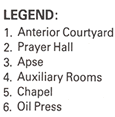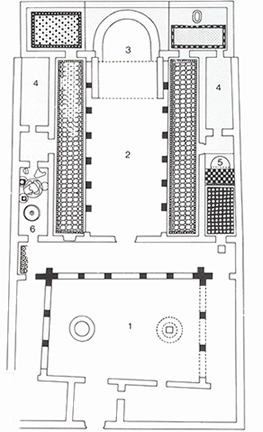 |
 |
 |
 |
|
Kursi
National Park
|
|||
| Description \Descriere | |||
| Pictures \Poze | |||
| Map\Harta | |||
|
|
|||
|
updated:
23.01.06 21:21
|
| Kursi is localed east of the Sea of Galilee,
seven kilometers north of Ein Gev, at the junction road leading to the
Golan Heights via Giv'at Yoav. According to Christian tradition, Kursi is the site of the "Miracle of the Swine" mentioned in the New Testament (Luke 8:26-39 Matthew 8:23-34). It is identified with Gergessa or Gerasa, "which is the country of the Gadarenes, which is over against Galilee." Here, the New Testament relates, after Jesus had exorcised some devils from the body of a man, they possessed a herd of swine grazing nearby. The swine then raced into the Sea of Galilee and were drowned. Archaeological investigators identity the site as ancient Kurshi, mentioned in the Talmud as a center of idol worship. In 1970, the remains of an ancient structure were accidentally uncovered during road construction at Kursi. The site was excavated by Dan Urman and Vassilios Tzaferis of the Department of Antiquities and Museums, who unearthed the remains of the largest known Byzantine monastery in the Holy Land. The monastery, which had a church and was surrounded by walls, measured 145 x 123 meters. While the monastery was being reconstructed, additional excavations were conducted at a rock on a nearby hill. Here, a chapel paved with three separate layers of mosaics was found. Other finds included columns, a damaged inscription, and a stone bench for viewing the Sea of Galilee. The excavators assume that the Miracle of the Swine occurred near the rock. The monastery and church were probably built in fifth century CE The church was built in the basilica form with two rows of columns, which divide it into a nave and two side aisles. Near the apse (a semi-circular niche that protrudes from the building) is the baptistery, built at the end of the sixth century. Streets, fortifications and a variety of buildings were constructed around the monastery in order to serve the numerous pilgrims who frequented the area. In 614, during the Persian invasion of the Holy Land, the church was damaged, many of the other buildings were destroyed, and the area of settlement was substantially reduced. The church was later reconstructed, but at the beginning of the eighth century it was razed by fire. Ninth-century Arab settlers in the area used the remains of the cf1urch as homes and storage rooms. It is probably they who were responsible for the destruction of the figures in the mosaic floors. From the ninth century until the recent reconstruction, Kursi ceased to serve as a place of Christian pilgrimage. |
